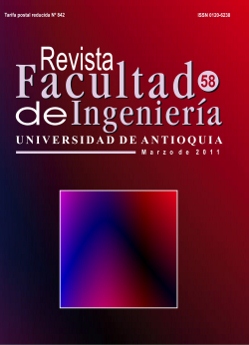Performance analysis of serial and shunt microwave switches designed with p-i-n diodes of different semiconductor materials
DOI:
https://doi.org/10.17533/udea.redin.14613Keywords:
p-i-n diodes, semiconductor materials, microwave switchesAbstract
A performance analysis of serial and shunt microwave switches based on p-i-n diodes of different semiconductor materials is presented. The materials analyzed are Si, GaAs, SiC, GaN, InP and GaSb. The serial type microwave switch designed with GaSb, GaAs, Si and GaN-ZB p-i-n diodes reach the lowest values of insertion losses compared to other materials. A 0.2dB inser-tion loss difference is perceived between GaSb and SiC6H p-i-n diodes. The optimal results of isolation for frequencies less than 10GHz is obtained with switches designed with SiC and GaN p-i-n diodes. The shunt type switches designed with GaN p-i-n diodes reach the lowest values of insertion losses compared to other materials. Approximately 0.2 dB insertion loss differences between the responses of GaN and Si pin diodes in the frequency of 40 GHz and a difference of 0.4 dB at 60 GHz frequency were identifi ed. GaN p-i-ndiodes are most recommendable for the design of shunt switch devices.
Downloads
References
A. Iturri Hinojosa, L. M. Resendiz, T. V. Torchynska. “Numerical Analysis of the Performance of PIN Diode Microwave Switches Based on Different Materials”. Materials Characterization Symposium at the XVIII International Materials Research Congress. Agosto 16-20. Cancun (Mexico). 2009.
PIN Diode Switch suits Wimax and Wi-Fi applications, M/A-COM Technology Solutions, Inc. http://news. thomasnet.com. Consultada el 25 de noviembre de 2009.
PHILIPS Electronics N.V. Application Note AN10173. 2000. pp. 1-2.
L. A. Iturri Hinojosa. Comparación de parámetros de dispositivos-diodos p-i-n de diferentes materiales para aplicaciones en antenas de arreglos de fase y sistemas radares. Tesis. Sección de Estudios de Posgrado e Investigación. UPIITA. Instituto Politécnico Nacional. México. D. F. 2010. pp. 85-100.
J. Putnam, M. Fukuda, P. Staecker, Y-H.Yun. “A 94 GHz monolithic switch with a vertical PIN diode structure”. IEEE GaAs IC Symposium. Octubre 16-19. 1994. pp. 333-336.
E. Alekseev, D. Pavlidis, J. Dickmann, T. Hackbarth. “W-Band InGaAs/InP Diode Monolithic Integrated Switches”. IEEE.. GaAs IC Symposium. Noviembre 3-6. 1996.
Gerald Hiller. Design with PIN Diodes. App Note 1002. Alpha Industries Inc. pp. 1-14.
J. White. Microwave Semiconductor Engineering. Ed. Van Nostrand Reinhold Company. New York. 1982. pp. 1-105.
R. Caverly, Hiller G. “Microwave Resistance of Gallium Arsenide and Silicon p-i-n Diodes”. IEEE MTT-S Digest. Vol. 2. 1987. 99. 591-594. DOI: https://doi.org/10.1109/MWSYM.1987.1132479
National Semiconductor Corporation (NSM). http://www.ioffe.ru/SVA/NSM/Semicond/. 2009. Consultada el 25 de noviembre de 2009.
S. M. Sze. Semiconductor Devices. 2ª. ed. Ed. John Wiley & Sons. New York. 2002. pp. 17-44.
Downloads
Published
How to Cite
Issue
Section
License
Copyright (c) 2018 Revista Facultad de Ingeniería

This work is licensed under a Creative Commons Attribution-NonCommercial-ShareAlike 4.0 International License.
Revista Facultad de Ingeniería, Universidad de Antioquia is licensed under the Creative Commons Attribution BY-NC-SA 4.0 license. https://creativecommons.org/licenses/by-nc-sa/4.0/deed.en
You are free to:
Share — copy and redistribute the material in any medium or format
Adapt — remix, transform, and build upon the material
Under the following terms:
Attribution — You must give appropriate credit, provide a link to the license, and indicate if changes were made. You may do so in any reasonable manner, but not in any way that suggests the licensor endorses you or your use.
NonCommercial — You may not use the material for commercial purposes.
ShareAlike — If you remix, transform, or build upon the material, you must distribute your contributions under the same license as the original.
The material published in the journal can be distributed, copied and exhibited by third parties if the respective credits are given to the journal. No commercial benefit can be obtained and derivative works must be under the same license terms as the original work.










 Twitter
Twitter